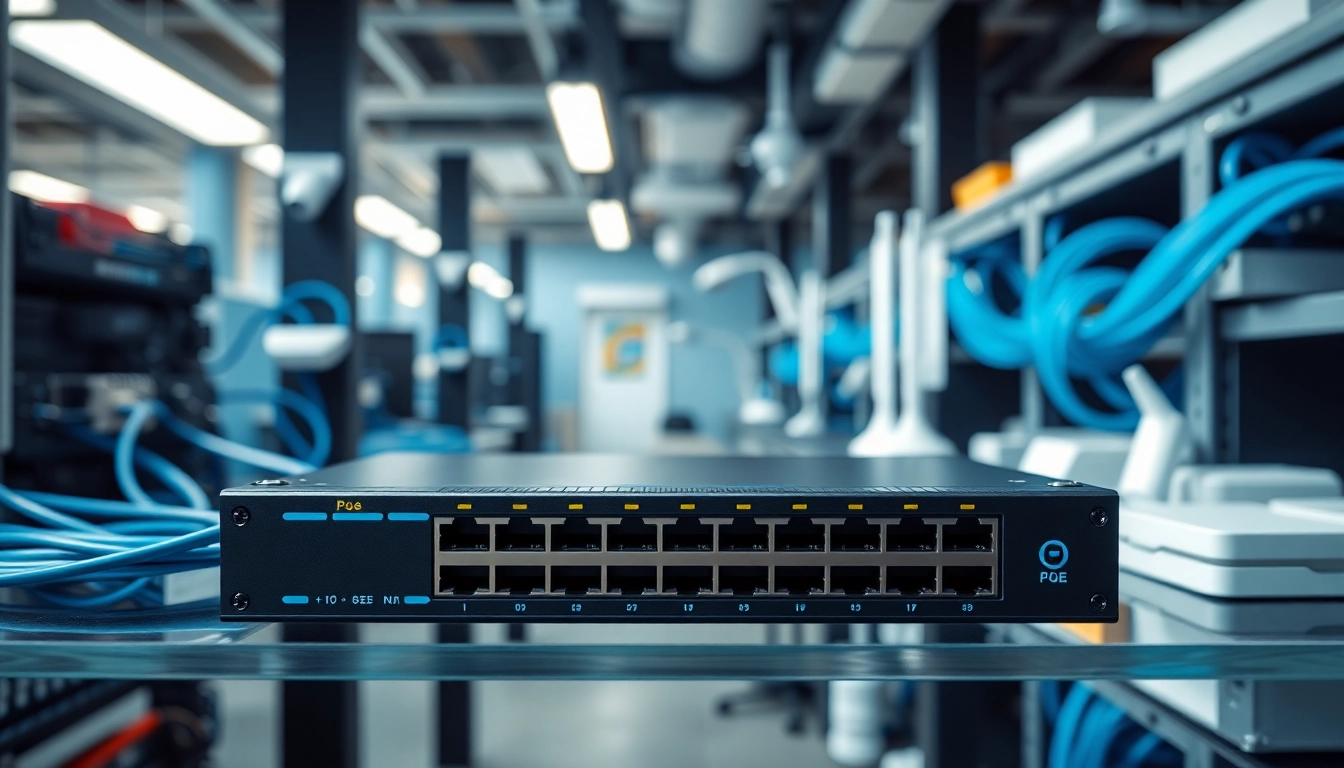Understanding POE Switch
What is a POE Switch?
A POE Switch, or Power over Ethernet Switch, is a type of network switch that can deliver both data and electrical power through a single Ethernet cable. This technology streamlines the process of powering network devices such as IP cameras, wireless access points, and VoIP phones without needing separate power sources. By transmitting data and power simultaneously, POE Switches reduce the need for multiple cables, thereby simplifying installation and enhancing the efficiency of network setups.
The implementation of POE technology has significantly changed how networking is approached, especially in environments like office buildings, warehouses, and public spaces. Utilizing a POE Switch allows businesses to create a flexible, scalable networking solution that can accommodate a range of devices with varying power needs.
How Does a POE Switch Work?
At its core, a POE Switch operates through the use of standard Ethernet cables. It detects whether a connected device is POE-compatible, initiating the transfer of power once a compatible device is recognized. The communication between the switch and device utilizes the IEEE 802.3af or IEEE 802.3at standards to regulate the voltage and ensure devices receive an appropriate amount of power.
The process starts when a device is plugged into one of the switch’s POE ports. The switch performs a Power Device Detection sequence, confirming compatibility. Once detected, power is fed through the same Ethernet cable that carries data. The POE Switch supplies different power levels, typically 15.4 watts with IEEE 802.3af or up to 30 watts with the IEEE 802.3at standard, ensuring that devices that require varying wattages function effectively.
Benefits of Using POE Switch
Incorporating a POE Switch into a network offers several advantages. These include:
- Reduced Cabling Costs: By delivering power and data through one cable, overall installation costs decrease as fewer cables and power outlets are required.
- Simplified Installation: Devices can be placed in locations that may not have power outlets nearby, enhancing flexibility and ease of setup.
- Centralized Power Management: POE Switches allow for easier management of power supply. If a device needs troubleshooting or repair, it can be powered down from the switch.
- Scalability: Additional devices can be connected easily, making it straightforward to scale the network as the organization grows.
- Enhanced Reliability: The use of POE Switches can lead to fewer power supplies and cables, reducing the chance of failure and maintaining a cleaner environment.
Types of POE Switch
POE Switch vs. POE+ Switch
Understanding the difference between POE and POE+ is crucial for making informed decisions about networking solutions.
A standard POE Switch (IEEE 802.3af) delivers up to 15.4 watts of power per port, which is often suitable for devices such as IP cameras and basic wireless access points. On the other hand, POE+ (802.3at) offers a higher power output of up to 30 watts per port, making it ideal for more power-intensive devices including advanced wireless access points and surveillance cameras with pan-tilt-zoom (PTZ) capabilities.
Choosing between the two depends on the specific requirements of the connected devices, where POE+ significantly supports more demanding applications.
8-Port and 24-Port POE Switch Explained
POE Switches come in various configurations to suit different networking needs. The two common options are 8-port and 24-port switches.
An 8-port POE Switch is ideal for smaller networks, such as in homes or small offices, where a limited number of devices are connected. They tend to be more compact and less expensive, making them an economical choice for basic setups.
In contrast, a 24-port POE Switch is designed for larger environments, where many devices need to be connected simultaneously. This configuration suits businesses or organizational departments, offering scalability and flexibility for future expansion. With a 24-port setup, users can connect multiple devices without the immediate need for additional switches.
Choosing the Right POE Switch for Your Needs
Selecting the right POE Switch involves assessing several factors:
- Device Requirements: Evaluate the power requirements of the devices you plan to connect. Determine whether they need standard POE or POE+.
- Number of Ports: Consider how many devices you need to connect now and in the future to select the appropriate number of ports.
- Network Speed: Ensure the switch supports the desired data transfer speeds, such as Gigabit Ethernet for high-speed data needs.
- Budget: Weigh the features against your budget. More advanced switches typically offer enhanced features but at a higher cost.
Installation and Setup of POE Switch
Step-by-Step Installation Guide
Installing a POE Switch involves several essential steps to ensure a successful setup:
- Select the Installation Location: Choose a centralized location to reduce cable length and ensure optimal functionality.
- Connect the Switch to Power: Plug the POE Switch into a power source. Ensure the switch’s performance is not hampered by any circuit overload.
- Connect Devices: Use Ethernet cables to connect each device to the switch. Make sure that each device is POE-enabled to receive power.
- Test Connectivity: Power on the switch and check the connectivity of each device. Use LED indicators on the switch to confirm that devices are receiving power.
- Configure Your Network: Depending on the switch’s capabilities, set the network parameters such as VLAN settings, QoS, and security features.
Common Installation Mistakes and How to Avoid Them
When installing a POE Switch, several mistakes can lead to performance issues:
- Overloading the Switch: Ensure that the total power demand of connected devices does not exceed the switch’s capacity.
- Poor Cable Management: Use adequate cabling practices to maintain organization, reduce interference, and avoid accidental disconnections.
- Neglecting Firmware Updates: Regularly check for and install firmware updates to enhance security and performance.
- Ignoring Power Budgeting: Plan for future device needs to prevent the need for immediate upgrades.
Best Practices for Configuring Your POE Switch
To optimize the use of a POE Switch, it’s crucial to follow best practices during configuration:
- Utilize VLANs: Implementing Virtual Local Area Networks (VLANs) can enhance network performance and security by segmenting devices.
- Enable QoS: Quality of Service settings allow prioritization of critical network traffic, ensuring that important data flows smoothly without interruption.
- Implement Security Features: Utilize port security protocols and enable monitoring tools to safeguard your network.
- Document the Configuration: Maintaining detailed records of your network configuration aids in troubleshooting and future upgrades.
Monitoring and Maintenance of POE Switch
Tools for Monitoring Your POE Switch Performance
To ensure your POE Switch operates optimally, regular monitoring is essential. Tools that can aid in this effort include:
- Network Monitoring Software: Solutions like SNMP (Simple Network Management Protocol) tools help in overseeing network performance, diagnosing issues, and tracking usage stats.
- Power Management Tools: Utilize software that monitors power consumption of connected devices. This can provide insights into overall system health and power efficiency.
- Log Review Tools: Analyzing switch logs helps track port activity, errors, and security issues. Regular reviews can preempt major problems.
Routine Maintenance Tasks for Optimal Performance
Performing routine maintenance ensures that your POE Switch continues to function smoothly:
- Regular Firmware Updates: Keeping the firmware up to date protects against vulnerabilities and enhances features.
- Cleanliness: Ensure that air vents are free from obstructions to maintain proper ventilation and prevent overheating.
- Inspect Cables: Regularly check the integrity of Ethernet cables for wear and tear that may affect performance.
- Review Power Budgets: Reassess the power distribution regularly to accommodate any new devices without overwhelming the power supply.
Troubleshooting Common Issues with POE Switch
Common issues that may arise with POE Switch and how to troubleshoot them include:
- No Power to Device: Verify that the device is connected to a POE port and check that the port is enabled.
- Intermittent Connection: Check cable integrity and ensure connections are secure. Use shorter, high-quality cables if necessary.
- Slow Network Speeds: Investigate bandwidth usage across the network and optimize QoS settings to ensure that critical applications receive the required bandwidth.
The Future of Networking with POE Switch
Emerging Trends in POE Technology
The landscape of networking is constantly evolving, and POE technology is at the forefront of innovation:
- Higher Power Requirements: As devices become more sophisticated, future POE standards may support higher wattage to accommodate advanced technologies like IoT sensors.
- Integration with Smart Technologies: LOL (Light over Ethernet) technologies may emerge, combining lighting systems with data networks.
- Software-Defined Networking (SDN): POE technology is likely to be integrated with SDN tools, allowing for more dynamic control over network resources and power.
The Role of POE Switch in Smart Buildings
POE Switches are integral to the implementation of smart building technologies. They provide a streamlined way to connect and power various devices, including sensors, cameras, and smart lighting systems. With the rise of smart buildings focusing on energy efficiency, POE technology becomes essential for powering devices without the complexity or environmental impact associated with traditional wiring setups.
Predictions for POE Switch Developments in the Next Decade
The coming decade may see revolutionary developments in POE technology. With increasing compatibility with IoT devices, we can expect POE Switches to become more versatile in handling diverse applications. Advanced monitoring features may be integrated into switches, providing real-time analytics on energy usage and device performance. Furthermore, awareness regarding energy efficiency and reduction in carbon footprints may push businesses to adopt POE technology more widely as they look to create sustainable infrastructures.



